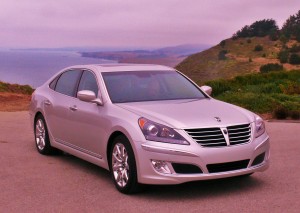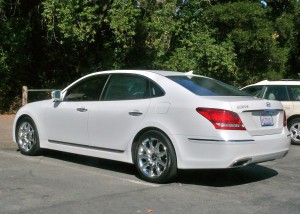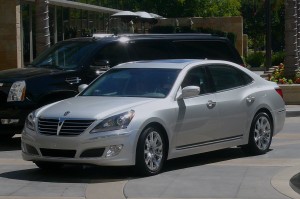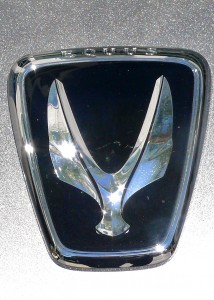Equus takes wing as luxury-level Hyundai
PALO ALTO, Calif. —The North American introduction of the 2011 Hyundai Equus was well orchestrated, but in a way, I felt like I had cheated. I had gotten a brief, and swift, early sample of the Equus, which was definitely more impressive than anything we could do on the twisting mountain roads near Palo Alto.
A couple of months before the late-August introduction of the Equus in North America, I had the opportunity to visit Korea, ostensibly to try the new Sonata Hybrid and Sonata 2.0 Turbo models at Hyundai’s research and development track. It is a huge layout, with various handling courses, and room for a slalom, acceleration and braking tests, all encircled by a 4-kilometer high-speed oval track. The highest lane on the oval is banked at 43 degrees — steeper than Talladega, if you’re a NASCAR fan.
The plan was to venture onto the high-speed track to try the Sonata with its soon-to-come 2.0-liter turbo engine, so my co-driver and I hustled over to a 2.0 Turbo parked on an escape road halfway down the straightaway on the oval. But a couple of other journalists beat us to the Sonata. There was another car parked there — a long, luxurious sedan, sitting in stately elegance. “Can we take that one out?” I asked the Korean fellow monitoring the one-lap runs of the 2.0 Turbo Sonata.
“Sure,” he said, with a shrug.
I had been thinking that Hyundai might surprise us with a first-look view of the Equus on that trip, but I hadn’t expected to be able to drive it. Especially on a high-speed oval that I didn’t know existed. I jumped at the chance and climbed behind the wheel. We were waved onto the track. Being halfway down the straight and knowing we would only get one lap, I stepped hard on the gas.
The big car surged forward, and I stayed on it as I entered the track and pulled over into the far, left lane. Almost immediately we were into the turn, and I kept my foot into it as I eased up onto the highest part of the high bank. It was simple to keep the front end aimed at the dotted line and the big Equus planted firmly to the track surface. We zipped around the turn with complete precision, and as I came down off the banking, I glanced at the speedometer cluster, and read “130” miles per hour. Very impressive. I stayed on it as we leveled off on the backstraight, and the speedometer climbed easily to 140 before we were already at the other end, where I circled the high bank again, and had to decelerate coming off it to gracefully enter the return lane on the far right.
It wasn’t until after the trip that I learned most of my fellow journalists hadn’t had the chance to get behind the wheel of the Equus. So I didn’t talk about it too much. But the memory stood out, after other impressive runs in the turbo and the hybrid. I finally did get out on the oval in the Sonata 2.0 Turbo, and that midsize sedan flew through the turns and clocked an easy 130 on the straightaway.
During those four days in Seoul, I noticed many large, classy sedans with Equus labels on the rear end. Some were stretched into limousine length, but all of them had simple but glamorously understated lines. Hyundai didn’t start making its own engines until 1991, but had built Korean versions of other manufacturers before that. In 1999, Hyundai partnered to build a Korean version of a Mitsubishi luxury car, which became the Equus, and that model has endured until now.
For 2011, Hyundai is unveiling the second generation Equus to the U.S. market. The new car is entirely different, and 100-percent Hyundai. It came only after Hyundai had satisfied itself that the introduction of the Genesis three years ago was convincing evidence that Hyundai was a company that could be trusted to make luxury cars. The Genesis won 2009 North American Car of the Year honors, and its new 4.6-liter high-tech V8 engine has made the Ward’s 10-Best engine list since its inception. John Kravcik, the president and CEO of Hyundai of America, explained that everybody knows Mercedes, BMW, and Audi are qualified to make true luxury cars, and more recently Toyota with Lexus, Honda with Acura, and Nissan with Infiniti proved that the Japanese could also qualify as luxury car-makers. Hyundai wanted to make sure the world was ready for a Hyundai luxury car before going ahead with the new Equus. Kravcik said, “Hyundai has 4 million cars on the road right now, and some of those owners are looking to move up.”
Hyundai lined up the Mercedes S550, BMW 750L, Lexus LS460, Audi A8L, and Cadillac STS and ranked them for exterior design, interior design and comfort, driving stability, NVH (noise, vibration and harshness), ride comfort, braking, and vehicle dynamics. Hyundai’s executives are far too courteous to declare superiority in any of these categories, but by using the best of those selected competitors as benchmarks, Hyundai was able to combine the best levels of each category into the Equus.
When you figure that the primary targets of Mercedes, BMW, Audi and Lexus flagships all cost in the neighborhood of $80,000 to somewhere well over $100,000, the Equus will be a bargain — a very competitive car at an anticipated sticker price of $60,000, which will be stunning to anyone who compares features and qualities and price in their quest for unbridled automotive excellence. But the Equus will not be a bargain-basement luxury car, except in price.
It will reach showrooms by November, and will come in only two models. As Krafcik explained, “The Signature will have every feature you ever wanted, and the Ultimate will have features you didn’t know you could have.”
Some of those features are, indeed, clever. Each Equus will come with an iPad, which contains the owner’s manual. Kravcik said he checked all the premium cars’ owner’s manuals and some were over 1,000 pages. That made listing everything categorically on an iPad, where service appointments can also be scheduled, made contemporary sense. There will be only 250 U.S. dealers qualified to sell Equus, and Hyundai aims to sell only 2,000 to 3,000 annually in the U.S., with anywhere from 10,000-50,000 worldwide. Naturally, those estimates will depend on demand, and production could increase.
“Equus is a pilot brand for us, and if it’s as good as it could be, we’ll find a way to build more,” said Kravcik, who admitted that the continuing success of Genesis and the anticipated demand for Equus could lead Hyundai to creating a separate Lexus-style dealership network.
It is an intriguing project, to make something so opulent and yet so simple. Only two models, and only four colors — black, white, granite gray, and platimum silver — and with interiors that feature walnut or birch wood trim, and black, cashmere or saddle colored leather, which are careful to minimize processing for a more natural look and feel. By anticipating limited sales at first, Hyundai is offering free valet service for five years and 60,000 miles — the dealership picks up your car for service and delivers it back, and leaves you an Equus to drive in the meantime.
Scott Margason, director of product planning, described a couple of other unique interior features, such as powre 60-40 reclining rear seats, with power rear and rear side sunshades, plus a Lexicon 7.1 discrete surround sound system with 17 speakers and all imaginable connectivity, and standard navigation screen. Moving up to the Ultimate, Hyundai aimed to match first-class airline comfort in the rear, where air cells heat and cool you, and provide a stimulating or relaxing massage — stronger than that in the driver’s seat — plus the ability to recline while a leg-support ottoman pops out, and power switches control the headrest and its tilt angle. The optional rear center console contains a thermoelectric refrigerated bin, and rear occupants get their own 8-inch entertainment screen. Windshield glass is both rain-repelling and acoustic laminations.
Structurally, the Equus starts with an assortment of high-grade steel, with 30 percent high-tensile, 38 percent ultra-high-tensile, and 7 percent super-ultra-high-tensile boron, for strategic stress points. Inside that sleek body, which registers 0.27 for a coefficient of drag, the engine is the Genesis 4.6 V8, with rankings of 385 horsepower and 378 foot-pounds of torque using premium fuel, and 333 horses with 324 foot-pounds if you use regular. That’s right, use regular if you want, but know that performance might drop slightly. Also, while we’re appreciating the potency of the 4.6, Hyundai is readying an ellarged 5.0-liter V8 that could fill the engine bay of the front-engine, rear-drive sedan.
The ZF 6-speed automatic transmission is designed in coordination with the engine and electronic management system. The air suspension offers controlled damping and can adjust to raise the car over an inch if more ground clearance is needed for that grass-in-the-middle road to the cabin. When cruising at 70 or above, the car automatically lowers a half-inch for better aerodynamics. Electrically-boosted steering can be set for sport or normal, as can the suspension and transmission.
On the highway, the Equus is smooth and remarkably silent, but it also has that strong heart of an engine, with sportshift manual capabilities and that tight, curve-carving handling, on every U.S. highway even if you’ll never have the chance to run 140 on a test-track. On top of everything else, the Equus logo is outstanding, and I only slightly ruffled some Hyundai feathers, so to speak, when I called it “a bird.” Actually, it’s a stylized Pegasus, the mythical winged horse, but thankfully there are no horse parts visible. Just wings.
That works, in case Hyundai decides to branch off a luxury arm, or just as a symbol that, after some good little cars, SUVs, sporty coupes, and more recently the splendid Sonata, it’s time for Hyundai’s luxury soul to take wing.
Comments
Tell me what you're thinking...
and oh, if you want a pic to show with your comment, go get a gravatar!






 John Gilbert is a lifetime Minnesotan and career journalist, specializing in cars and sports during and since spending 30 years at the Minneapolis Tribune, now the Star Tribune. More recently, he has continued translating the high-tech world of autos and sharing his passionate insights as a freelance writer/photographer/broadcaster. A member of the prestigious North American Car and Truck of the Year jury since 1993. John can be heard Monday-Friday from 9-11am on 610 KDAL(www.kdal610.com) on the "John Gilbert Show," and writes a column in the Duluth Reader.
John Gilbert is a lifetime Minnesotan and career journalist, specializing in cars and sports during and since spending 30 years at the Minneapolis Tribune, now the Star Tribune. More recently, he has continued translating the high-tech world of autos and sharing his passionate insights as a freelance writer/photographer/broadcaster. A member of the prestigious North American Car and Truck of the Year jury since 1993. John can be heard Monday-Friday from 9-11am on 610 KDAL(www.kdal610.com) on the "John Gilbert Show," and writes a column in the Duluth Reader.